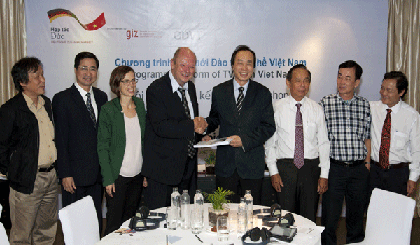81 teachers successfully trained in Vietnamese-German cooperation on PVT 2008
The General Directorate of Vocational Training (GDVT) under the Vietnam’s Ministry of Labor, War-Invalids and Social Affairs and the Deutsche Gesellschaft für Internationale Zusammenarbeit (GIZ) GmbH on November 11 co-organised the closing workshop for the technical cooperation of the Program Vocational Training 2008 (PVT 2008).
PVT 2008, a component of the Program Reform of TVET in Vietnam, was agreed by Vietnamese and German Governments in 2008 within the framework of the Vocational Training sector of the Vietnamese - German Development Cooperation.
The financial cooperation activities implemented by KfW Development Bank include the delivery and installation of training equipment in the respective fields. The program aims at increasing the provision of demand-oriented trained and qualified labor force for sectors with growth potential through support to selected TVET institutions.
 |
| GIZ Senior Technical Advisor Mr Beate Dippmar (fourth from left) and Director General of Directorate of Vocational Training Mr Duong Duc Lan at the event. (Photo: Hoang Anh). |
PVT 2008 applied a new approach in the selection of the partner TVET institutions. A set of criteria, reflecting the employment-relevance of training, financial self-sustainability, the competence level of personnel, and organisational set-up and efficiency were developed jointly by GDVT, KfW Development Bank and GIZ and used to assess and select TVET institutions. With this new approach, it has chosen the most relevant TVET institutions as beneficiaries of the project, namely An Giang Vocational College, Long An Vocational College, Ninh Thuan Vocational College, Bac Ninh Vocational College of Economics and Technology, and Viet Bac VINACOMIN Industrial Vocational College.
In the context of the cooperation, the PVT 2008 has been supporting the five partner institutions through further training in order to enable teachers to develop and implement labour market-oriented training courses in selected occupations of metal cutting&Computerized Numerically Controlled CNC, electrics/electronics, and mechatronics. It also provides the institutions’ managerial staff with training aimed at promoting cooperation with the business sector, capacity planning and the efficient management of workshops.
In the framework of the PVT 2008 and during the capacity development implemented by GIZ, a number of German and Vietnamese experts provided support to the selected TVET institutions. After four years of implementation, the following results have been achieved:
* In addition to four handbooks regarding vocational pedagogy and workshop management, 28 sets of teaching and learning materials on various training modules for metal cutting&CNC, electrics/electronics, and mechatronics have been adapted and developed.
* Some 81 teachers have been successfully trained in the supported occupations of metal cutting &CNC, electrics/electronics, and mechatronics. The evaluation with assessment tools based on German standards showed an improvement of their practical competences. Moreover, 64 management staff attended management skill trainings.
* Models for cooperation with the business sector have been introduced and piloted in partner TVET institutions. As many as 13 types of cooperation with enterprises have been categorized and are implemented according to the local demands. Experiences from the successful cases were compiled in a guideline for cooperation with the business sector.
* Three quality management instruments, including tracer study, enterprise survey and workshop management, have been successfully piloted and implemented at the partner TVET institutes.
* Four photo exhibitions were organized in three supported TVET institutions to improve the image of vocational training in the nation.
Beside sharing, displaying and recognizing the achievements and learning from each other’s experiences, TVET stakeholders also work together on solutions for sustaining and promoting the achievements both at the central and at the implementation levels.
(Source: CPV)
 về đầu trang
về đầu trang






